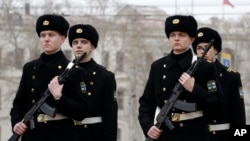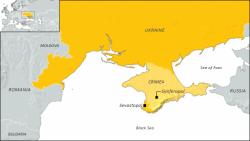Crimea is a peninsula on the northern coast of the Black Sea and an autonomous Russian-speaking republic of Ukraine.
In its early history, it was colonized and occupied repeatedly - by the Greeks, Romans, Huns, the Byzantine Empire, among others. In the 13th century, Crimea was occupied by the Tatars - Turkic-speaking Muslims who were part of the Golden Horde, a branch of the Mongol Empire established by a grandson of Genghis Khan.
The Crimean Khanate became a vassal state of the Ottoman Empire in the 15th century, but also a power in its own right, claiming territory in what is today Russia's Caspian-Volga region. Crimea was conquered by the Russian Empire in 1783.
The Crimean War of 1853-56, which pitted Russia against an alliance of Great Britain, France, Sardinia and Turkey, was fought mainly on the peninsula. The allied forces took the city of Sevastopol, the home of the Tsar’s Black Sea Fleet, after a long siege, and by the war’s end, the Crimea lay in ruins.
During the civil war that broke out in the wake of the 1917 Russian Revolution, Crimea was the scene of brutal fighting between Tsarist, Bolshevik and anarchist forces. Following the Bolshevik victory, Crimea was made part of the Russian Soviet Federative Socialist Republic (RSFSR).
*An autonomous republic in Ukraine
*Located on a peninsula between the Black Sea and the Sea of Azov
*Annexed by Russia in 1783 and was transferred to Ukraine in 1954
*Simferopol is the capital
*Port of Sevastopol is home of Russia's Black Sea Fleet
*Ethnic Russians account for more than half the population
*Official language is Ukrainian but many inhabitants speak Russian
*Population is two million
*Area is 26,100 square kilometers
In 1944, Soviet dictator Josef Stalin deported the entire Crimean Tatar population to Central Asia and other parts of the Soviet Union for their alleged collaboration with the Nazis.
In 1954, the Soviet Union, now under the leadership of Nikita Khrushchev, transferred Crimea from the RSFSR to the Ukrainian Soviet Socialist Republic.
After the fall of the Soviet Union in 1991, Crimea became part of independent Ukraine, and Moscow and Kyiv agreed to divide up the former Soviet Black Sea Fleet. Crimea's port city of Sevastopol remains the base for Russia's Black Sea Fleet.
Ethnic Russians account for 58 percent of Crimea's population, while Ukrainians make up 24 percent. Crimean Tatars, who began returning to the peninsula from exile after the fall of the Soviet Union, comprise 12 percent of its population.
In a recent poll of Russians by the state-run All-Russia Center for the Study of Public Opinion, 56 percent of the respondents said they saw Crimea as belonging to Russia.
Smaller numbers of those polled said they felt the same way about two of Russia's Muslim regions - Dagestan (41 percent) and Chechnya (39 percent).
In its early history, it was colonized and occupied repeatedly - by the Greeks, Romans, Huns, the Byzantine Empire, among others. In the 13th century, Crimea was occupied by the Tatars - Turkic-speaking Muslims who were part of the Golden Horde, a branch of the Mongol Empire established by a grandson of Genghis Khan.
The Crimean Khanate became a vassal state of the Ottoman Empire in the 15th century, but also a power in its own right, claiming territory in what is today Russia's Caspian-Volga region. Crimea was conquered by the Russian Empire in 1783.
The Crimean War of 1853-56, which pitted Russia against an alliance of Great Britain, France, Sardinia and Turkey, was fought mainly on the peninsula. The allied forces took the city of Sevastopol, the home of the Tsar’s Black Sea Fleet, after a long siege, and by the war’s end, the Crimea lay in ruins.
During the civil war that broke out in the wake of the 1917 Russian Revolution, Crimea was the scene of brutal fighting between Tsarist, Bolshevik and anarchist forces. Following the Bolshevik victory, Crimea was made part of the Russian Soviet Federative Socialist Republic (RSFSR).
Crimea
Facts About Crimea*An autonomous republic in Ukraine
*Located on a peninsula between the Black Sea and the Sea of Azov
*Annexed by Russia in 1783 and was transferred to Ukraine in 1954
*Simferopol is the capital
*Port of Sevastopol is home of Russia's Black Sea Fleet
*Ethnic Russians account for more than half the population
*Official language is Ukrainian but many inhabitants speak Russian
*Population is two million
*Area is 26,100 square kilometers
In 1954, the Soviet Union, now under the leadership of Nikita Khrushchev, transferred Crimea from the RSFSR to the Ukrainian Soviet Socialist Republic.
After the fall of the Soviet Union in 1991, Crimea became part of independent Ukraine, and Moscow and Kyiv agreed to divide up the former Soviet Black Sea Fleet. Crimea's port city of Sevastopol remains the base for Russia's Black Sea Fleet.
Ethnic Russians account for 58 percent of Crimea's population, while Ukrainians make up 24 percent. Crimean Tatars, who began returning to the peninsula from exile after the fall of the Soviet Union, comprise 12 percent of its population.
In a recent poll of Russians by the state-run All-Russia Center for the Study of Public Opinion, 56 percent of the respondents said they saw Crimea as belonging to Russia.
Smaller numbers of those polled said they felt the same way about two of Russia's Muslim regions - Dagestan (41 percent) and Chechnya (39 percent).






